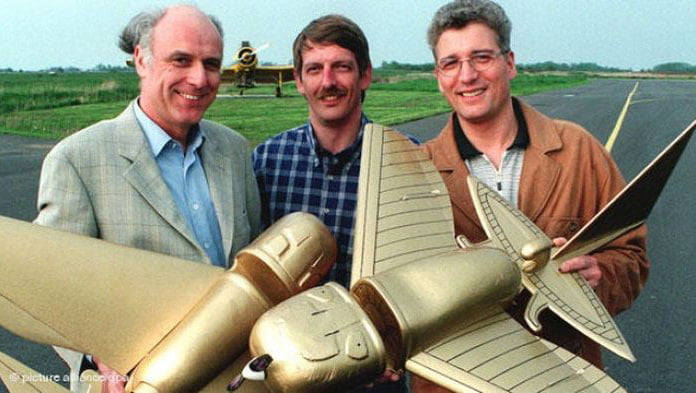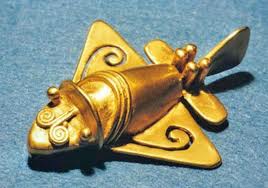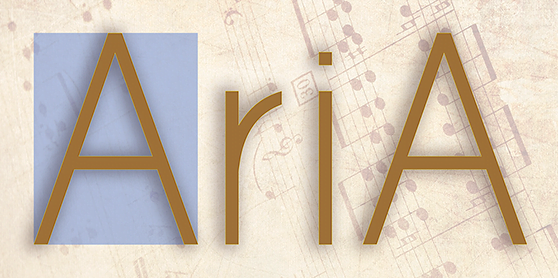At the beginning of the twentieth century, in a tomb dating back to 1500 of the pre-Columbian civilization known as Quimbaia, some 100 small figurines representing animals such as: insects, fish, birds, lizards, bats, frogs and cats were found. Among these figurines, however, there were some that have puzzled many archaeologists and scientists. After all, these figures resembled modern flying machines. And so far, the mystery of the golden Inca figurines has not been solved.
in the 1950s, several pieces of pre-Columbian art, including those that looked like small aeroplanes, were donated by the Colombian government for exhibition in half a dozen US museums, including the Metropolitan Museum of Art in New York. In the late 1960s, a replica of one of these strange and mysterious little planes fell into the hands of Ivan T. Sanderson. The "little golden aeroplane" was a gift from his old friend Emanuel M. Staub, a Philadelphia craftsman who specialised in making replicas of antique jewellery for museums.
The fragment analysed by aviation experts (and which served as a model for the scale model of the drone) is not authentic, but a "contaminated" copy. Anyone who visits Hall 2 on the ground floor of the Gold Museum in Bogotá, where the "little gold planes" are displayed, and compares them with the OOPART photograph popularised by supporters of the existence of "ancient astronauts", will be disappointed. None of the works of ancient jewellers labelled as "zoomorphic figures" resemble the copy made by Staub. In other words: the most similar copy claiming to prove that ancient man flew into space is... a fake.

The mystery of the golden Inca figurines, an investigation...
In fact, not all aviation experts were unanimous in their assessment of the identification of the fragment with the aircraft. As usual, for supporters of the existence of "ancient astronauts" only those arguments that seem to support their theory take place. It is therefore not surprising that the literature on the subject omits the analysis of the third of the experts to whom Sanderson referred: Arthur M. Young (1905-1995), eminent philosopher and populariser of science, famous for his role as inventor, who designed the first Bell-47 helicopter for civilian use and, curiously, very interested in all those issues bordering on science, such as parapsychology. Young's views on pre-Columbian flying machines are discouraging:
"Certainly the figure resembles the image of an aeroplane, especially the vertical tail surface, which no other bird or insect has. But the wings are poorly positioned in relation to the centre of gravity. Also, the nose (or cockpit) is not aerodynamic. Although it may seem so at first glance, the specimen does not look like an aircraft at all. In any case, it is an interesting object and the tail fin is mysterious, although of course no one is an expert in this area".

Apart from the Staub jeweller's 'version' of OOPART, the truth is that the mystery of pre-Columbian 'little planes made of gold' remains unanswered: what are these fantastic figures that resemble strange creatures and fabulous winged dragons flying across the sky? In order to understand whether the ancient astronauts existed, it may be necessary to place these "planes" in their true coordinates, that is, in their ecological and shamanistic context. From a purely naturalistic point of view, perhaps the natives were reflecting the nature around them, giving free rein to their imagination.
In Keepers of the Universe? (1980), Ronald Storey, author of several books critical of Daniken's theories, suggests that the zoomorphic figures that inspired his replica aeroplane may represent the manta fish (Manta birostris) that natives may have seen on the fringes of the Pacific. Another possibility is that the diverse fish and insect fauna found in the Magdalena Basin was an inspiration for the Aboriginal people. They imagined fantastic creatures, such as reptiles with wings like birds' wings and as tiny as insects.

In the context of primitive shamanic culture, these objects were probably used as talismans or magical objects: hybrid creatures in the form of a fish (water) with the wings of a bird (air) and a golden jaguar (earth), symbolising power over the elements of water, air and earth.
Nevertheless, the scientists' conclusions are not indisputable either. The Incan gold figurines remain a mystery and will probably always be so. There is no way to know for sure, we need a living witness from that time ... We have to make conjectures and assumptions. Scientists based on their experience, and ordinary people based on their imagination.


 and then
and then 
